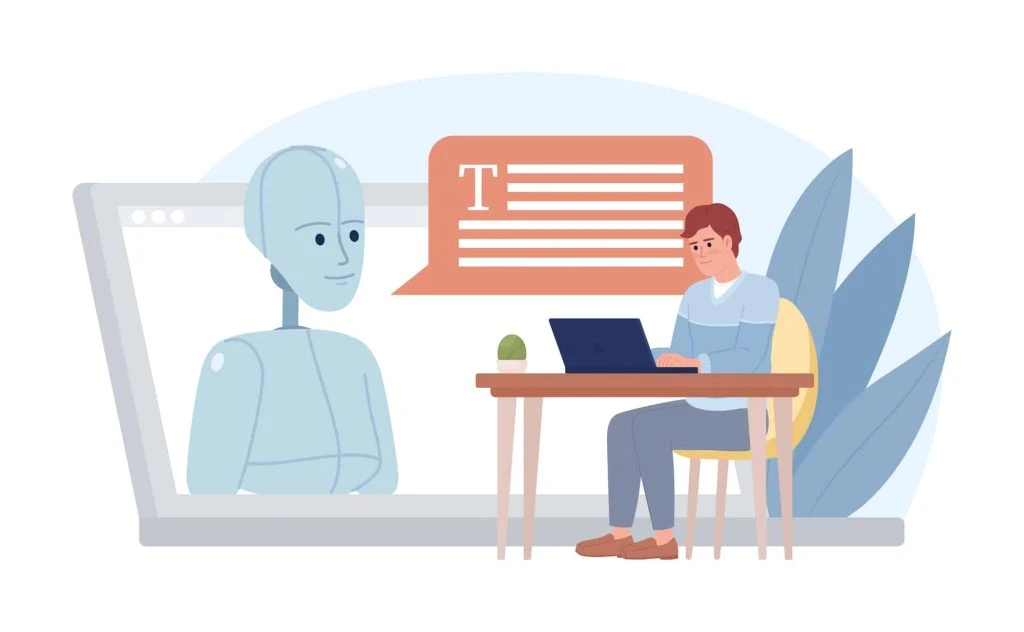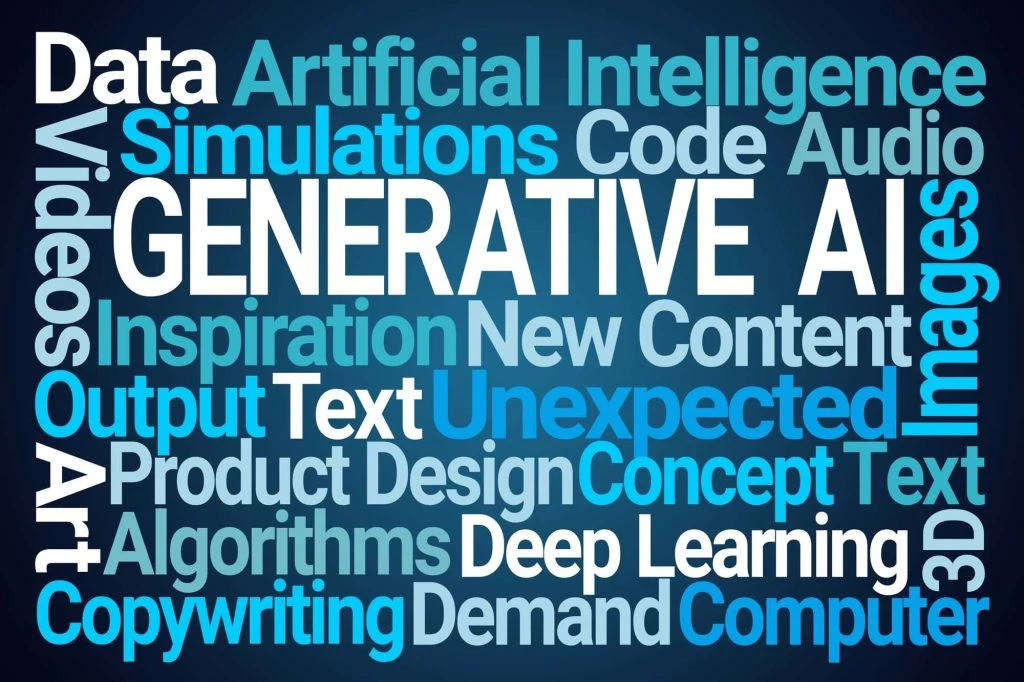With the launch of Open AI’s ChatGPT in late 2022, the AI revolution has officially advanced to “writing” content. At this stage, most of us are familiar with the use of AI to engage in basic chats and handle basic customer support functions using a series of pre-programmed responses, but can AI really write an entire blog post, or a series of witty social media ads? The answer is, yes, with a few caveats (we will discuss these in depth in just a bit).
The latest iteration, known as Generative Pre-trained Transformer (GPT), uses both Natural Language Processing (NLP) and Machine Learning (ML) to interpret written text prompts and use patterns recognized in published work to predict the best possible response. Originally used to provide more helpful live-chat responses, the most recent generation relies on over 175 billion detail parameters and a database of information scraped from the public web to create long-form content that goes far beyond a typical chatbot conversation.
Now for the million-dollar question: Can you use AI copywriting tools to handle all of your business content creation needs? At this point, no, AI is still not ready to replace your human writers and marketers (again…we’ll explain why in the next sections). That being said, you can use these tools and services to supplement your human copywriting efforts, saving yourself a bit of time and money, and freeing your team up to work on more productive tasks.
How Do AI Copywriting Tools “Write” Content?

First, let’s take a moment to understand what it means, in layman’s terms, to generate written content using AI. We briefly discussed the technology behind AI writing tools, but what do GPT, NLP, ML, and all of the other tech jargon really mean when it comes to generating content for your business?
In a nutshell, it means that an AI copywriting tool will use a written text prompt or a query provided by you as a starting point to create a piece of written content. AI tools have been trained on a massive database of publicly available content across the web and their “knowledgebase” reflects the data that was available through 2021. When you enter your query or content request, the AI content generator will scan this database and employ predictive pattern-matching algorithms to generate the requested piece of content. The content produced by modern AI copywriting tools is generally well-written, free of grammatical errors, and advertised as plagiarism-free.
Now we are going to dig a little deeper to explore a couple of those caveats we mentioned earlier.
Is AI Copywriting Ethical…Or Legal?

First and foremost, AI content generation, whether it be artwork or the written word, is still operating in a very murky legal gray area. The many legal and ethical controversies surrounding the use of AI to generate “original” content are not likely to be resolved anytime soon. So, let’s talk about some of the top concerns and the steps you can take to mitigate your risk by being a responsible and ethical AI consumer.
First, AI content generators are simply repeating what the web crawlers have scraped from the internet. These tools lack the human ability to employ critical thinking, lived experience, or a host of other nuanced human skills to detect when information found on the web may be incorrect, biased, or satirical. The AI tool sees all information as factual and that means that it is going to incorporate all of this information into the content it writes. This means that the familiar adage, “you can’t believe everything you read on the internet”, applies to your AI-generated content as well. You are definitely going to need a human fact-checker to check your AI-generated content for accuracy before publishing it to the web.
Next, we get to the ethical (and potentially legal) challenges presented by the use of AI to generate content. The problem arises from the fact that AI is not truly generating original thoughts or putting those thoughts into written form in the way that a human writer does. Instead, the AI tool is using the works of others to generate written content. In many cases, the original authors or creators of the works that the AI is drawing information from have not given their consent for their work to be used in this way.
This has already led to several copyright-related lawsuits. There is currently no sure-fire way to say who legally owns the rights to work created by AI. The best way to stay on the safe (and ethical) side of this controversy, is to use AI copywriting tools as a supplemental “idea-generation” tool, while still relying on your human writing team to shape these ideas into truly original and accurate content in the way that only humans can.
AI Copywriting: Pros
When used responsibly, as we discussed above, AI copywriting services can help you shave a great deal of time off your current content generation process, and save you the expense of hiring an in-house writing team, or a professional marketing agency. You will still need human writers to create high-quality nuanced content, that is factual and truly original. However, AI copywriting services can be a great way to generate content ideas, article outlines, and lightweight copy like product descriptions, social media ads, and other short-form marketing-related materials.

Idea Generation
Even the best writers struggle with bouts of writer’s block. In fact, the more writing that you do the more likely that you are eventually going to find yourself staring at a blank page wondering what to write about next.
AI copywriting tools have access to a massive trove of ideas that far exceeds what any one human could possibly know at any given time. This makes AI an awesome brainstorming partner.
Simply provide a few prompts to let the tool know what type of content you need and generate as many fresh new ideas as you need. This is a great way to flesh out your content writing calendar with potential topics for your human copywriting team to turn into high-quality posts, articles, marketing campaigns, and more.
Bulk Tasks
For larger brands, businesses, or marketing agencies with a high volume of repetitive copywriting tasks, AI writing tools could be used as a way to power through the bulk writing production, freeing up your human writing team to use their talent and skill for the completion of more nuanced and complex writing projects.
Versioning
AI copywriting tools are able to generate written copy quickly. This means that they could be used for cost-effective and efficient versioning to provide customized content for each individual client. In this use scenario, you could use AI to generate generic content freeing up your human writing team to use their talent and expertise to add the nuanced touches that personalize the content for each unique brand, customer, or purpose.
Save Time & Money
Making use of AI to handle some of your more repetitive, simple, or mundane copywriting tasks can help you better use your human copywriting team for more specific tasks. This may ultimately help you save both time and money when meeting your copywriting workload needs.
AI Copywriting: Cons
At first blush, AI copywriting can seem like a massive win in terms of increased productivity and decreased costs. However, there are several disadvantages to using AI to perform copywriting tasks. These weaknesses may be resolved at some point far in the future, but as of right now, they remain challenges that users must be aware of. Remember, trying to save a few minutes, or a few dollars upfront can end up costing you far more in the long run so proceed with caution and weigh the following AI copywriting risks carefully.

Unoriginal
The biggest, and the most prescient, issue surrounding AI copywriting is the lack of true originality in the work. As we discussed earlier, AI tools were trained on material created by human writers and artists. These are the resources that the AI copywriting tool is using to “write” content. This means that the AI tools are essentially “spinning” the content of writers. While not technically plagiarism in the strictest sense, spinning is plagiarism-adjacent and is generally considered to be unethical and unprofessional.
Furthermore, in many cases, the human writer or artist whose work is being sourced by the AI tool has not given permission for their work to be used in this manner. This opens up those who use this content to the risk of copyright violations in the future.
Bland & Boring
The first roll-out of the AI models produced some alarming passages containing toxic language, obvious bias, and misinformation. The AI tool lacks human discernment and therefore simply repeats whatever it encounters on the web. As most know, the web is full of the aforementioned content, so the AI tool is going to regurgitate these ideas and statements as often as it offers more fact-based content. It simply can’t tell the difference. In order to correct this problem, the developers instituted a number of guardrails that prevent the AI tool from returning potentially offensive content. While this action was necessary to prevent harm, the new guidelines have resulted in the AI tool producing content that is carefully scoured of any possibly offensive content, leaving it very bland and generic.
Awkward
The AI natural language model has improved quite a bit from its earliest iterations. That being said, there is still a gap between the writing of an actual human writer and the content produced by a computer program. Every culture has its own unique dialects and vernacular. This is especially true when it comes to the English language. In America alone, you will find different labels for common items depending on the region of the country you happen to be in. A human writer will know when “freeway” will make more sense to the reader than “expressway” or “parkway”, and when “soda” will resonate more than “cola” or “pop”. All of these terms are correct but knowing when and where to use each is something that AI has not quite mastered yet.
Additionally, AI has been trained to write in proper English. While technically correct, this can actually read as awkward to most human readers. As humans, we simply do not think, speak, or write in proper English form outside of legal, academic, and scientific applications.
Robotic
We, humans, are emotional creatures. For better or worse, emotions play a role in almost every decision that we make. This is especially true in our buying decisions. One of the key goals of any good marketing campaign is to find a way to connect to your potential customers on a personal level and evoke a strong emotional response, from nostalgia to excitement to concern, in an effort to motivate them to purchase, subscribe, or engage with the brand or business.
AI does not possess the ability to understand human emotion, and without that depth of understanding, it is not able to connect with humans on an emotional level. AI has been trained to make puns and tell simple knock-knock jokes, but it lacks the ability to understand the humor in the mundane. AI can “parrot” the opinions of others but it does not have the ability to recognize irony, tragedy, or heart-warming elements in the content it scans. Human readers and writers recognize all of these things, often without even realizing it. It turns out that conveying true and honest human emotion and building a genuine personal connection still require a writer that is…well, human.
How Will AI Copywriting Fit Into The Current Copywriting Ecosystem?

AI has certainly been the top disruptive technology trend of the past decade. Some are titillated by the seemingly endless doors of opportunity that AI development opens for those who have the foresight and imagination to see the potential. Others are concerned and apprehensive about the dangers to society as a whole and to the individual workers who find their income erased by a computer program. Both of these positions are valid. AI is already causing large corporations and brands to re-evaluate their workflow and labor needs with a move toward outsourcing tasks to AI.
So how does AI impact the copywriting industry, specifically? At this stage, AI copywriting tools are not able to fully replace the work of a human writer. The nuanced knowledge, discernment, and human emotion required to produce truly impactful writing absolutely require that a human is at the helm. That being said, AI copywriting tools can certainly be used to enhance or improve the copywriting process. Combining the efficiency of AI copywriting, with the talent of a human writer may provide businesses, brands, and agencies with a “best-of-both-worlds” copywriting process that saves time and money and optimizes the return on their investment.
Final Thoughts

AI copywriting has evolved over the past several years to offer a range of enhanced tools that go beyond simply creating text. Many of the top copywriting services now offer valuable features like data analytics, audience targeting, and built-in SEO tools as well. These extra-value features can be used to help maximize your copywriting efforts and impact when used in conjunction with your human copywriting team.
That being said, even the most-advanced AI copywriting tools are still subject to the inherent risks and weaknesses discussed earlier in this post. Namely, content is not always factual, may be biased, and may not be wholly original. This presents real ethical and potential legal challenges when using AI-generated content to promote your business or brand.
At the end of the day, AI copywriting services can be an awesome way to supplement and enhance your human copywriting efforts. These tools can help fuel brainstorming sessions, generate content ideas, and help to fine-tune your content for maximum marketing impact. Pair the power of AI with the creativity, talent, and knowledge of your human copywriting team to optimize your content generation strategy.
For more information about our unlimited copywriting services, click here.
